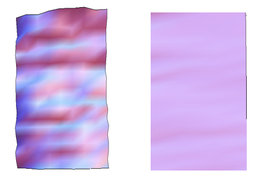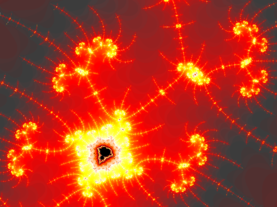
IRIS login | Reed College home Volume 96, No. 2: June 2017
Reed Prof Finds Fractal Geometry in Mouse Cortex
Fractals, the bizarre geometrical shapes that undergird natural phenomena from snowflakes to lightning bolts, have been discovered in a new and striking location: the synapses of the brain.
In a recent paper, professor Richard Crandall '69 [physics 1978–] and colleagues at the Reed Center for Advanced Computation found intricate fractal patterns in synapses in the somatosensory neocortex of a mouse brain.
Crandall's team (which included Cindy Joe '08, Tracy Mehoke '08, Devin Chalmers '08, Noah Pepper '09, and Kevin Lynagh '10) investigated a database that contained three-dimensional coordinates of more than one million synapses from the cortex of an adult mouse, which were obtained from the laboratory of cellular biologist Stephen J Smith '70 at Stanford University School of Medicine.
To the untrained eye, the resulting "point cloud" of synapses (points of connection between neurons) appears random, like a swarm of bees. But by borrowing insights from nuclear physics (the Yukawa potential) and geometry (the Hilbert curve), the researchers demonstrated that the synapses follow the fiendish rule of fractal patterning, with each layer of the brain echoing the structure of the layer beyond.
"The fractality suggests that the brain parts are somehow arranged so that function is related to geometry,'" Crandall says.
Fractals have a long and fascinating history. Certain elements of fractal geometry were discussed by German philosopher Gottfried Leibniz, but the concept did not really take shape until the 19th century with mathematicians such as Georg Cantor and Henri Poincaré. The hallmark of fractals is a property known as self-similarity, where the big, broad patterns of a structure are mirrored in miniature at successively finer levels of detail. Thus the spires of a snowflake, magnified at successive powers, repeat the same pattern over and over. Similarly, the exuberant swoop of a fern is rehearsed at every level, from the tiniest hair to the mightiest frond.
Mathematicians have used this concept to create shapes of ferocious, mind-bending intricacy. The Hilbert curve, for example, is a single line of infinite length and zero width whose labyrinthine path is so dense that it occupies every point in the unit square, making it a sort of dimensional mutant—half-line, half-square. The Mandelbrot set is a galaxy of geometrical nebulae whose edges are in constant evolution, shooting off microscopic galaxies in their turn. The self-repeating properties of fractals are so peculiar that Poincaré once described them as "a gallery of monsters."
Fractals are often characterized as having a fractional dimension, hovering in a sort of mathematical twilight between the reassuring domains of line, plane, and solid. In the case of the mouse cortex, the researchers measured the overal fractal dimension of the synapses at roughly 2.8.
To understand what this means, return to the swarm of bees. If the bees lined up one behind the other single-file, their dimension would be one; if they flocked together to form a disk, their dimension would be two; and if they buzzed around in a random cloud, their dimension would be three.
Perhaps more important, the researchers found that each layer of the brain has a slightly different fractal signature, again suggesting that function is related to geometry.
Finding fractal patterns in a relatively small sample of mouse synapses is particularly significant, because it suggests that the phenomenon will be even more pronounced in larger, more complex structures. The mouse brain contains more than a hundred billion synapses; the human brain, hundreds of trillions.
It remains unclear whether there are any medical implications to the discovery that the brain exhibits fractal geometry. "It's so far beyond our current understanding of the brain that it's hard to know what the significance is," says professor Steve Arch [biology 1972–2012] who is acknowledged in the paper for his conceptual contributions to the project.

However, the author suggests in a footnote that the ability to measure the fractal dimension of a brain may one day contribute to the detection of certain conditions such as Alzheimer's syndrome.
Crandall is a pioneer of computational physics and mathematics. In 2001, he and a group of Reed students at the Center for Advanced Computation proved that F24, otherwise known as the 24th Fermat Number, or 2 to the power of (two to the power of 24)) +1, was not a prime number, as had been speculated by Pierre de Fermat in the seventeenth century.
Crandall is also the author of the irrational base discrete weighted transform, an algorithm that is used to find very large prime numbers. He is currently Vollum Adjunct Professor of Science at Reed, and is also head of Apple Computer's Advanced Computation Group.
(The two purple charts illustrate the fractality of the brain. The chart on the left shows how the fractal dimension of the brain changes as one descends through the six layers of the mouse cortex. The chart on the right shows a hypothetical "random" brain with dimension 3.0)
GO FURTHER
On the fractal distribution of brain synapses, in Computational and Analytical Mathematics, Proceedings, in Springer Series in Mathematics and Statistics, 2013.
Tags: alumni, Apple, bio, brain, computing, F24, fractals, geometry, Hilbert Curve, math



LATEST COMMENTS
steve-jobs-1976 I knew Steve Jobs when he was on the second floor of Quincy. (Fall...
Utnapishtim - 2 weeks ago
Prof. Mason Drukman [political science 1964–70] This is gold, pure gold. God bless, Prof. Drukman.
puredog - 1 month ago
virginia-davis-1965 Such a good friend & compatriot in the day of Satyricon...
czarchasm - 4 months ago
John Peara Baba 1990 John died of a broken heart from losing his mom and then his...
kodachrome - 7 months ago
Carol Sawyer 1962 Who wrote this obit? I'm writing something about Carol Sawyer...
MsLaurie Pepper - 8 months ago
William W. Wissman MAT 1969 ...and THREE sisters. Sabra, the oldest, Mary, the middle, and...
riclf - 10 months ago